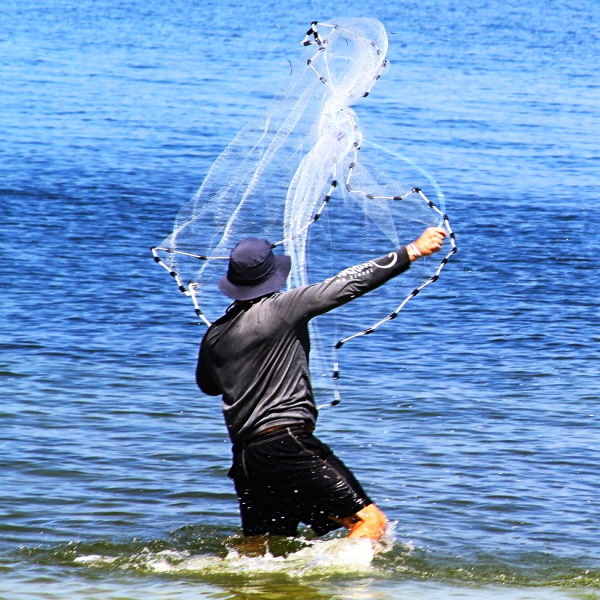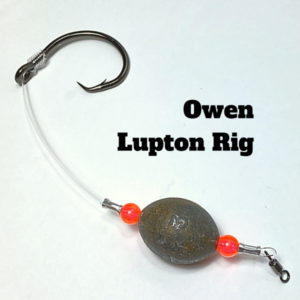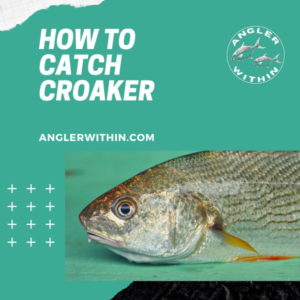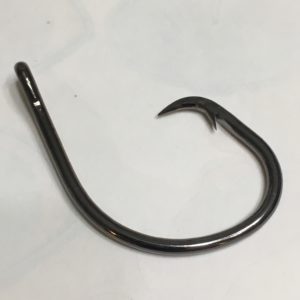
When choosing a cast net for the beach, sink rate is less important that it may normally be. That’s because you’ll typically be throwing in fairly shallow water. With that said, I’d still opt for a net that has at least 1 lb. of lead weight per foot. You don’t necessarily need the pricier 1.5 lb./ft. nets for the surf.
When it comes to size, the best nets for the beach are between 6 and 8 feet. This size is a good combination of effectiveness and ease of throwing. You might consider staying with a 6 foot net if a primary goal is to keep your loadout as light as possible.
I think the best cast net for surf fishing is a 3/8″ mesh 7′ monofilament net with 1 lbs. of lead per foot.
There are many good brands on the market, but one of the best known and most widely available is Betts. These are fairly priced quality nets with a solid reputation. The specific net that I chose to go with is a 7′ Betts Old Salt 3/8″ mesh net. These are commonly found in bait shops and tackle stores all over the place, but I just ordered mine from Amazon.
If you wish to buy a single net that’s good for the beach, the docks and a boat, a 3/8″ 8′ foot net is hard to beat.
Regardless of which cast net you choose for the beach, you really can’t go wrong with any of these 3 sizes – 6′, 7′, 8′. All of them are easy to master and are plenty capable of capturing bait from the surf.
Beware that the maximum allowable size of cast nets can differ by region. It’s my understanding that in Texas, for example, allowable cast nets must be 7′ (radius) or smaller. Check your regulations!
5 Main Cast Net Factors To Consider
- Mesh Size (the small square openings of the net)
- Size Of The Net (radius)
- Weight Of The Net (lead line poundage per foot)
- Skill Level (are you a beginner?)
- Local Laws (some states restrict the maximum radius)
1. Best Mesh Size For The Beach
For beach use, you’ll be choosing between a 1/4″ and 3/8″ mesh net. Either will work good from the sand, but my preference is 3/8″ as that is a good all around size for the baits you would typically target in the surf.
It really depends on what size bait you’re after as to which mesh size you should go with. 3/8″ is better for medium sized bait, whereas you might consider going with 1/4″ mesh if you’re after really small minnow sized bait.
Without delving too deep, the most common mesh size for the beach is a 3/8″ square mesh net. Such a net will usually be constructed of 8 lb. test mono and is good for catching pinfish, finger mullet, scaled sardines and other such medium sized fish.
1/4″ Mesh
1/4″ mesh sinks slower, but is usually ok from the beach as you won’t be casting into very deep water. This size is good for relatively shallow water 4 to 6 feet deep and will catch 2-3″ small minnow sized bait fish.
3/8″ Mesh
3/8″ mesh sinks faster than 1/4″ and is considered to be the most versatile mesh size. It catches pinfish, finger mullet and scaled sardines.
Gilling Fish
The problem with going with too large of a mesh is that you may throw on a school of bait that can fit perfectly into the mesh openings. When that happens, the fish’s gills get stuck as they pass through the holes. This results in what is sometimes referred to as “Christmas treeing your net”. You can end up with a net full of small fish stuck all in your net. It can be time consuming to remove all those tiny fish one by one. So, just be aware of what size mesh you’re throwing when targeting a particular school of bait.
2. Ideal Cast Net Size (Radius) For The Beach
For those totally new to cast netting, you might not realize that the size measurement used when referring to cast nets is the radius not the diameter. Therefore, when we are talking about a 6 foot net, for example, it actually opens up to about 12 foot wide.
Different size nets have their pluses and minuses. As with anything there is always give and take. This is certainly true when it comes to choosing which size cast net, as discussed below.
Large Nets Cover More Water
Larger nets can stretch out and cover much more bait with each cast. However, the larger you go, the heavier the net gets and the harder it is to throw.
Net Size Should Somewhat Match Your Height
For beach use, ideally you’ll choose a net that you can fully extend when hanging it with one hand way above your head. I am of average size, so for me that is a 7′ net. Taller anglers can probably comfortably handle an 8′ net, whereas shorter anglers may want to stick to a 6′ net.
Big Nets Are Heavy
Big nets mean more weights. More weights mean a heavier net. While I do agree that big nets are typically superior, that doesn’t mean they are the best option for the beach. That’s just my opinion. When lugging a cast net across the sand, weight can start to become an issue.
Mid-Sized Nets Are Ideal For The Beach
I call a net between 6 and 8 feet a midsized net. In my opinion these are the best sizes to use from the beach. Keep in mind, when casting from the beach you are battling waves and wind while potentially standing in hip deep water. That’s not a great recipe for successfully throwing a huge net. That’s why I prefer to stick to the 6-8 foot range.
Another nice advantage of a 6-8′ net is that kids and smaller individuals can usually handle this size. So, why not let the kids have a go at casting from the beach as well?
3. Weight Of A Cast Net
Cheaper nets will have 1 lb. of lead per foot whereas more expensive nets will have 1.5 lbs. per foot or more. There are both pros and cons to going with a lighter or heavier net.
Heavier Nets Add To Your Beach Loadout Weight
As you can imagine, a large net with a heavy lead line will be a tough load across the beach unless you have a beach cart.
Weightier Nets Pierce The Wind Better
On the beach you’ll be often dealing with very windy conditions. Therefore the case can be made to go with a heavier 1.5 lb/foot net. These heavier nets will definitely cost you more money, which may not be what you’re going for with your first cast net purchase.
Heavy Cast Nets Obviously Sink Faster
Cast nets with heavier lead are also generally better overall because they will sink faster. 6 foot nets at 1.5 lb’s per foot are 9 lbs. total. 7 foot nets at 1.5 lb./ft are 10.5 lbs. and so on. Therefore, I wouldn’t suggest buying a 12 foot net for the beach unless you are able to drive your vehicle onto the sand and have the skills to throw a really large net. I think a good sweet spot is a 6 to 8 foot net with 1 to 1.5 lbs. per foot of weight. I would stay away from anything with less than 1 lb./ft.
Heavier Nets Tire You Out
Another downside to a heavy net is that they can start to tire you out with repeated throws. With a large net you definitely want to make sure you see the bait before you throw. Otherwise, you will wear yourself out casting blind.
4. Skill Level Will Limit The Size Of Net That You Should Choose
Firstly, a smaller net is generally easier to throw for most people. Secondly, as a beginner, you might throw into areas that you probably should not cast on. For example, you should avoid oyster bars and jetty rocks. That’s a sure way to destroy or lose a net. It’s better to lose a smaller and thus cheaper net as move through the learning process.
5. Legal Considerations For Cast Nets
When purchasing a cast net, you need to be aware that the maximum size is regulated in some areas. Texas comes to mind, with their 7′ maximum size.
Additionally, even though we are not discussing boat usage here, you aren’t necessarily allowed to keep as many cast nets on your boat as you might like. I just use this as another example of regulations surrounding cast nets. Check your regs!
Beach Cast Net Tips
Don’t Throw Your Net Blindly
When choosing when to throw your net, wait to see some evidence of bait in the water before throwing. You should first spot the bait or at least spot some disturbance along the surface of the water before you throw. Otherwise, you’ll tire yourself out throwing at empty water.
Polarized Glasses Are A Huge Advantage
Polarized sunglasses are a great help for spotting bait before casting your net. Oftentimes the bait are not right on the surface and can be difficult to spot without a nice pair of shades.
Don’t Throw Small Nets Onto Large Fish
Generally speaking, you don’t want to toss a small lightweight net onto large fish, particularly onto large schools of large fish. This is a good way to damage your net.
Prepping Your New Cast Net
As weird as it sounds, you should soak a new cast net in fabric softener for a while before first use. To do so, you should place your new net in a bucket of freshwater and fabric softener for 8 hours or more. This softens the net and causes it to operate better. Side bonus – it also makes it smell nice!
Cleaning And Storing Your Cast Net
When cleaning your net do not use strong soaps as they can damage the monofilament. Just use freshwater to clean your net before storage, but don’t seal it up wet.
After cleaning, you need to let it dry out before storing it. It’s best that you hang your net vertically to dry it out, but you should not suspend the weights off the ground as that will stretch the net. Instead, either allow the weights to barely sit on the ground, or you could also drape your net across something, such as a railing.
Finally, be sure to store your cast net away from sunlight and moisture between uses.
Throw Ahead Of The Bait
When targeting moving schools of bait, try to aim ahead of them. This is where a larger net does give you a huge advantage. If you cast a 5 foot net, the bait only has to swim 5 feet in order to escape the sinking net, whereas if you cast a 10 foot net you have much more leeway.
The smaller the net you go, the more anticipatory you’ll likely have to be with your casts as you must lead the net ahead of the direction that the fish are swimming.
Don’t Throw On Too Small Of Bait For Your Mesh
If you throw on a school of bait that is approximately the exact same size as your mesh opening what will happen is that you will likely gill them. The bait will partially go through the net and get stuck in the openings. This creates a mess for you to clean up and can kill the bait. This is one of the reasons why your choice of mesh size is important to consider.
Keep Your Net Away From Oyster Beds!
Be sure to avoid throwing over oyster beds or jetty rocks. This is a sure way to shred a cast net.
What Baits You Can Cast Net From The Surf
When it comes to the actual bait you will be targeting, there are many options. Of course the most prevalent baits will vary depending on what region you are in. Common cast net catches are finger mullet, menhaden and whiting.
Conclusion
When it comes to choosing a net specifically for the beach you don’t have to overthink it. Just purchase a 6-8′ net from a reputable manufacturer. The mesh size can be either 1/4″ or 3/8″, and the minimum weight needs to be 1 lb. or greater. If you have the budget, go for 1.3 lb. or greater to improve your sink rate. Just be aware that the larger and heavier net that you choose has to be transported across the sand. If you have a beach cart this isn’t much of a concern, but if you’re carrying your net by hand this weight adds up quick. In the end, my recommendation for a starter cast net for the beach is the 7′ Betts Old Salt net with 3/8″ mesh. That’s what I have.
Augustus Clay
If you found this article helpful, you might like some of my other surf fishing articles linked below.
Best Beach Cart For Surf Fishing
How To Catch Sharks From The Beach
How To Catch Bull Reds From Shore



